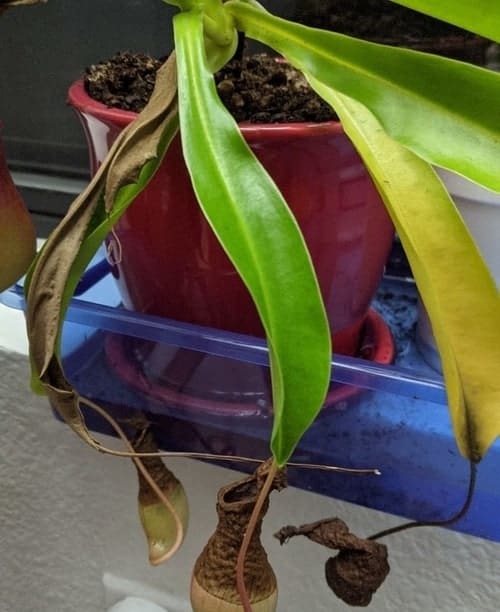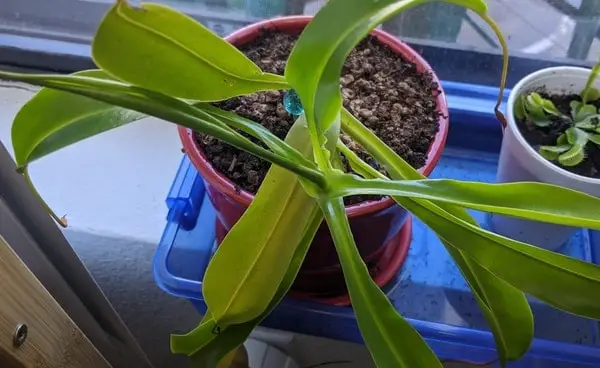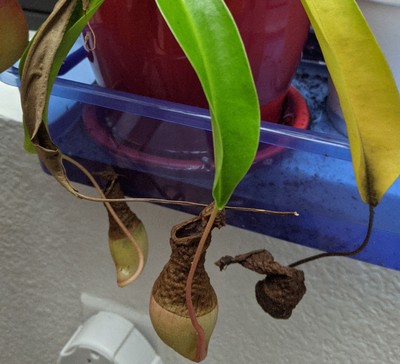Black leaves are common in Pitcher plants. Dried up leaves are not necessarily a warning sign, as many different factors can cause them.
Their natural lifecycle usually causes black leaves in Pitcher plants; old leaves wither while new ones spur from the center. Black leaves can also be a sign of dormancy or poor growing conditions, such as excessive sunlight or lack of humidity.
This article will explore the most common causes of black leaves and methods to avoid losing leaves due to common care mistakes.
What Causes Black Leaves in Pitcher Plants?
Black Leaves Due to Standard Leaf Rotation
Pitcher plants take only about six months to develop pitchers, but they take 5-10 years to fully mature and flower. Their lifespan ranges between 10-20 years. They use sunlight, water, soil nutrients, and prey to survive. Throughout their lifespan, they will occasionally shed some leaves and pitchers that are too old. For every leaf drying up there, there should be a new one growing.

Do not be overly worried when you see a leaf drying up and turning brown. Most of the time dried up leaves are harmless in Pitcher plants. The image above shows a healthy Pitcher plant with several brown leaves and pitchers. Even though the plant has lost some leaves, it is healthy. It has produced more leaves and pitchers than before in the latest months.
The Dormancy Period
Some varieties of Pitcher plants undergo a period of dormancy in the winter. During that period, the plant tends to produce more black leaves.
The Sarracenia pitcher plant native in North America, for example, develops non-carnivorous leaves from Autumn until the end of winter, and some other leaves will turn brown and die.
Even Nepenthes, which are tropical pitcher plants, undergo some physical changes to cope with winter. The days are shorter at this time of the year in tropical regions, so the pitcher plants conserve their energy. They grow at a slower rate and will shed some dried leaves and pitchers. Turning black or brown is a sign that they are drying up and about to shed.
Black Leaves Due to Improper Care
Many different factors can cause an increase in black leaves in your Pitcher plant. If your plant is not dormant and you observe several leaves dying up, those can be caused by improper growing conditions. This section will help you examine your setup and ensure your plant is receiving proper care. Also, it includes some tips on how to avoid black leaves.
Watering Technique
Nepenthes grow best in moist but well-drained soil. Even the top layer of soil has to stay moist as carnivorous plants are native to bogs. An easy way to maintain this is with the tray method. Put the pot on a tray and keep about 1/4 inch of water on the tray at all times. Allow the plant to be watered from the bottom and try not to water from the top to avoid getting water inside the pitchers. It is only advisable to keep about 1/2 inch of water in the pitchers if it is particularly dry.
The water used for this plant can only be rainwater, distilled water, or reverse osmosis water. Nepenthes are native to nutrient-poor habitats, and too many minerals in the soil may over-fertilize the plants. Keeping them under roof eaves or downspouts is also advisable, so they get ample rainwater. They can sometimes tolerate tap water, but the amount of minerals in tap water may differ according to where you live.
Humidity Requirements
Nepenthes need high humidity. Pitchers will not grow; they can dry up and die in low humidity (less than 30%-40%). Dried up leaves and a lack of pitchers are common signs of improper humidity levels. If you do not have a terrarium that can control the humidity, you can keep a humidifier near the plants to replicate a humid environment. Regularly misting them with water in a spray bottle will also help.
Be wary of other organisms that also thrive in high humidity, though. Do not keep the pitcher plants in a completely closed container because fungi and mildew might grow inside and kill the plant. Allow sufficient natural ventilation in the terrarium as well by keeping it slightly open.
Lighting Requirements
Carnivorous plants, not just pitcher plants, generally need lots of sunlight. Without plenty of lighting pitcher plants stop producing fluid (this is how you solve the lack of fluid in the pitchers), Venus fly traps stop growing traps, and many other issues.. The Highland species can survive in partial sun while the Lowland species will need full sun.
Place Pitcher plants outdoors in a spot where they can get unobstructed sunlight. If they are being kept indoors, place them near windowsills facing any direction except North. They will not get direct sunlight through a North-facing window. If they are kept in a terrarium, it is better to use fluorescent tubes designed for plant growth and set the timer at 12-14 hours. Read the Indoor Pitcher Plant Care Guide for more information and effective strategies to grow Pitcher plants in your home.
Optimal Temperature
Pitcher plants are resilient to various temperature levels. Indoor room temperatures are appropriate for most types of Pitcher plants.
A standard temperature range during the growing season is 60 – 80 F (15 – 27 C). Pitcher plants prefer stable temperatures within 60 – 80 F (15 – 27 C).
You should double-check the specific species you own or plan to buy and adjust the temperature accordingly.
Soil Composition
Sphagnum Moss and Perlite Potting Mix for Pitcher Plants
Pitcher plants thrive in nutrient-free soil. The minerals and fertilizers in standard soil can kill these plants.
Employ a mixture of long-fibered sphagnum moss or peat moss with perlite or sand as Pitcher plants. Each of the elements in the soil must be pure and lack any nutrients or fertilizers.
Pitcher plants do not need rich organic soil as they are native to nutrient-poor habitats. Their consumption of insects makes up for the soil’s deficiency in minerals.
For best results, make sure you use soil that provides aeration and retains moisture. This article can help you select the best soil for your pitcher plant.
Feeding Needs
Carnivorous plants need supplemental feeding for optimal growth. It is recommended that the plants are grown in an area with natural access to prey, like on an open window leading outdoors so they can feed themselves. An insect or two per month is sufficient if the plant has not caught anything by itself. Freeze-dried insects are available in pet shops, and you can also feed them crickets, wasps, cockroaches, and flies. Do not experiment with human food; stick with an insect-only diet for your Pitcher plant.
The pitchers could trap bigger prey like lizards and rats, but this is not advisable to allow them to feed on them because they take a long time to be digested and only emit a rotting smell. Also, as the animal rots, the leaf will dry up and die.
Do you want to learn how to feed your Pitcher plant? This guide can help you learn which bugs to employ and how to do it: What To Feed a Pitcher Plant: A Comprehensive List (Plus Feeding Tips)
Use of Fertilizers
Pitcher plants generally do not need fertilizing, but it’s not particularly bad for them. Use foliar spray and be careful not to overdo it because Nepenthes are especially prone to being over-fertilized. Indoor plants can be fertilized with 10% diluted orchid food twice a month during the growing season.
Excessive use of fertilizers can weaken the plant. Also, they can cause dried up leaves.
Are Dried up Pitchers Signs of a Dying Plant?
Not necessarily. Often, the Pitcher plants are just approaching dormancy, or the pitchers are old. Pitchers occasionally turn brown, dry up, then shed. It should only be a cause for alarm if the pitchers are drying up all at once outside dormancy season.
It could be tricky when the pitchers start drying up during Autumn, though. It is hard to tell if it is going dormant or dying and the only way to know is to wait out the dormancy season. The plant is fine if it starts growing late in spring or early in Autumn. If it doesn’t, then it only means it has died.
How to Prevent Pitcher Plants From Turning Black?
Caring for pitcher plants could be easy, but mistakes are easier to make, and they could spell the death of the plant if they’re not immediately addressed.
Remember that plants will only thrive in environments that mimic their natural habitat. Pitcher plants grow best in warm, humid, and bright conditions.

Follow this advice to keep your plant healthy and avoid losing leaves:
- Avoid playing with the leaves or the pitchers. Touching the plant can cause stress and leaf loss.
- Do not fertilize your plant. Only experienced growers should experiment with fertilizers.
- Grow your plant outdoors with several hours (10+) of direct or indirect sunlight.
- Plant Pitcher plants in carnivorous plant soil. Avoid standard using standard potting soil, as it is harmful for Pitcher plants.
- Water frequently to keep the soil moist but do not flood.
- Only employ nutrient-free water such as reverse osmosis water, distilled water, or rainwater.
- Feed your Pitcher plant only if it lives indoors (this guide can teach you the basics of the pitcher plant feeding process). (this guide can teach you the basics of the pitcher plant feeding process)..
- Only feed insects to pitcher plants, never experiment with human food or larger animals.
For more information on Pitcher plant care, make sure to download the complete care sheet here: Ultimate Pitcher Plant Care Guide.


